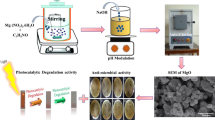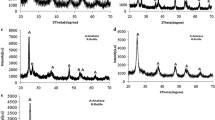Abstract
In the present work, Nickel doped Molybdenum trioxide (NixMoO3) where Ni = X (X = 5, 10, and 15%) nanoparticles (NPs) were synthesized by a wet chemical method. These nano crystals are structurely analysized by X-ray diffraction and confirm the formation of orthorhombic structure in both MoO3 and Ni-doped MoO3 samples. The impact of Ni doping on crystallite size, micro strain, and texture co efficient are obtained from XRD pattern. The morphology studies of FE-SEM and HR-TEM show that the presence of one dimensional (1D) nanorods with an average diameter of particle size around 28–32 nm and the compositional stoichiometry is confirmed by EDAX technique. The functional group and the vibrational mode of metal oxide (Mo = O) are confirmed by FT-IR spectra. The photocatalytic activities of pure and Ni-doped MoO3 are attributed to the degradation efficiency under UV–Visible light irradiation. The result shows that these structure exhibits promising degradation of Methylene blue (MB) is calculated along with the kinetic study, cyclic efficiency, and growth mechanism. The ability of the catalysts generates electron-hole pairs which create free radicals and also help to undergo the secondary reactions. The MoO3 and Ni-doped MoO3 samples normally reveal better results against in antibacterial activity such as Escherichia Coli (E. Coli) and Staphylococcus aureus (S. aureus) bacteria. Overall, the results demonstrate that the doping of Ni2+ ions inside the MoO3 matrix enhances the performance in antibacterial activity.

Highlights
-
Ni decorated MoO3 nanorods of various concentrations (5, 10 & 15%) have been investigated.
-
Morphological, structural & optical properties of Ni incorporation of MoO3 nanorods are studied by various experimental parameters.
-
Degradation rate constant is found through the pseudo-first-order kinetic model.
-
Recycle test and photocatalytic mechanisim are studied under UV-Visible light irradiation.
-
The bacteria strain observes through disc diffusion technique.











Similar content being viewed by others

References
Yang JF, Bian XF, Yuan ML et al. (2013) Excellent degradation performance of azo dye by metallic glass/titanium dioxide composite powders. J Sol-Gel Sci Technol 67:362–367
Rahimi R, Honarvar Fard E, Saadati S et al. (2012) (2012) Degradation of methylene blue via Co–TiO2 nano powders modified by meso-tetra(carboxyphenyl)porphyrin. J Sol-Gel Sci Technol 62:351–357
Jose M, Kumari M, Karunakaran R et al. (2015) Methylene blue adsorption from aqueous solutions using undoped and silver-doped nanotubes of anatase-titania synthesized via modified hydrothermal method. J Sol-Gel Sci Technol 75:541–550
Shaban M., Elwahab F. A., Ghitas A. E. et al. (2020) Efficient and recyclable photocatalytic degradation of methylene blue dye in aqueous solutions using nanostructured Cd1 − xCoxS films of different doping levels. J Sol-Gel Sci Technol. https://doi.org/10.1007/s10971-020-05331-x)
Shen J, Guo S, Chen C, Sun L, Wen S, Chen Y, Ruan S (2017) Synthesis of Ni-doped α-MoO3 nanolamella and their improved gas sensing properties. Sens Acts B 252:757–763
Qu Q, Zhang WB, Huang K, Chen HM (2017) Electronic structure, optical properties and band edges of layered MoO3 a first-principles investigation. Comp Mat. Sci 130:242–248
Magdalene CM, Kaviyarasu K, Vijaya JJ, Jayakumar C, Maaza M, Jeyaraj B (2017) Photocatalytic degradation effect of malachite green and catalytic hydrogenaration by UV-illuminated CeO2/CdO multilayered nanoplatelet arrays: Investigation of antifungal and antimicrobial activities. J Photochem Photobiol B: Bio 169:110–123
Li F, Li C, Zhu L, Guo W, Shen L, Wen S, Ruan S (2016) Enhanced toluene sensing performance of gold-functionalized WO3: H2O nanosheets. Sens and Acts B: Chem 223:761–767
Li C, Feng C, Qu F, Liu J, Zhu L, Lin Y, Wang Y, Li F, Zhou J, Ruan S (2015) Electrospun nanofibers of p-type Nio/n-type Zno heterojunctions with different Nio content and its influence on trithylamine sensing properties. Sens Acts B: Chem 207:90–96
Jiang D, Wei W, Li F, Li Y, Liu C, Sun D, Feng C, Ruan S (2015) Xylene gas sensor based on α-MoO3/α-Fe2O3 heterostructure with high response and low operating temperature. RSC Adv 5:39442–39448
Shafiei M, Yu J, Arsat R, Zadeh K-M, Comini E, Ferroni M, Sberveglieri G, Wlodarski W (2010) Reversed bias Pt/nanostructured Zno Schottky diode enhanced electric field for hydrogen sensing. Sens and Acts B: Chem 146:507–512
Luo M, Liu Y, Hu J, Liu H, Li J (2012) On -pot synthesis of Cds and Ni-doped Cds hollow spheres with enhanced photocatalytic activity and durability. ACS App Mat Int 4:1813–1821
Bernardes AA, Radtke C, Alves MCM, Baibich IM, Lucchese M, Dos Santos JHZ (2014) Synthesis and characterization of SiO2-CrO3, SiO2-MoO3 and SiO2-WO3 mixed oxide produced using the non-hydrolytic Sol-gel process. J Sol-Gel Sci Technol 69:72–84
Ahmed B, Ojha AK, Kumar S (2017) One-pot synthesis of Ni doped Cds nanosheets for near infrared emission and excellent photocatalytic materials for degradation of MB dye under UV and sunlight irradiation. Spect Act Par A: Mol. And Biomol. Spec 179:144–154
Kamoun O, Boukhachem A, Alleg S, Jeyadevan B, Amlouk M (2018) Physical study of nano-structures MoO3 films codoped with cobalt and nickel in which there is a ferro -diamagnetic transition. J Alloys Com 741:847–854
Zhu J-M, Hosseini M, Kakhri A, Rad SS, hadadi T, Nobakht N (2019) Highly efficient of molybdenum trioxide-cadmium titanate nanocomposites for ultraviolet light photocatalytic and antibacterial application influence of reactive oxygen species. J Photochem Photobio B: Bio 191:75–82
Van Heerden JL, Swanepoel R (1997) XRD analysis of ZnO thin films prepared by spray pyrolysis. Thin Sol Films 299:72–77
Zhang Y, Yuan J, Cao Y, Song L, Hu X (2008) Photochromic behaviour of Li-stabilized MoO3 sol-gels. J Non-Crys Sol 354:1276–1280
Nwanya AC, Deshmukh PR, Osuji RU, Maaza M, Likhande CD, ezema FI (2015) Synthesis, characterization and gas -sensing properties of SILAR deposited Zn-CdO nano-composite thin film. Sens Acts B: Chem 206:671–678
Shimomura T, Kim D, Nakayama M (2005) Optical properties of high-quality ZnO thin films grown by a sputtering method. J Lumin 112:191–195
Patil SB, Kishore B, Manjunath K, Reddy V, Nagaraju G (2018) One step hydrothermal synthesis of novel Cu2S-MoO3 nanocomposite for lithium ion battery and photocatalytic applications. Int J Hyd Ener 43:4003–4014
Gowtham B, Ponnuswamy V, Pradeesh G, Chandrasekaran J, Aradhana (2018) MoO3 overview: hexagonal plate-like MoO3 nanoparticles prepared by precipitation method. J Mater Sci: Mater Electron 29:6835–6843
Sirelkhatim A, Mahmud S, Seeni A, Kaus NHM, Ann LU, Bakhori SKM, Hasan H, Mohamad DJN-ML (2015) Review on Zinc oxide nanoparticles: antibacterial activity and toxicity mechanism. Nano-Micro Lett 7:219–242
Wu D, Han L (2019) Solvothermal synthesis and characterization of visible -light -active MoO3/ MoS2 heterostructure. J Sol-Gel Sci Technol 91:441–445
Khan ZR, Zulfequar M, Khan MS (2010) Optical and structural properties of thermally evaporated cadmium sulphide thin films on silicon (100) wafers. Mat Sci Eng: B 509:7337–7343
Mariappan R, Ragavendar M, Ponnusamy V (2011) Growth and characterization of chemical bath deposited Cd1-xZnxS thin films. J Alloys Comp 509:7337–7343
Kalantar-zadeh k, Tang J, wang M, wang KL, Shailos A, Galatsis K, Kojima R, Strng V, Lech A, Wlodarski W, Kaner RB (2010) Synthesis of nanomater- thick MoO3 sheets. Nano Scal 2:429–433
Siciliano T, Tepore A, Filippo E, Micocci G, Tepore M (2009) Characteristics of molybdenum trioxide nanobelts prepared by thermal evaporation technique. Mat Chem Phys 114:687–691
Liang R, Cao H, Qian D (2011) MoO3 nanowires as electrochemical pseudo capacitor materials. Chem Comm 47:10305–10307
Glaser T, Beck S, Lunkenheimer B, Donhauser D, Kohn A, Kroger M, Pucci A (2013) Infrared study of the MoO3 doping efficiency in 4,4’- bis (N-carbazolyl)-1, 1’-biphenyl (CBP). Organ Elec 12:575–583
Partibavarman M, Sathishkumar S, Prabhakaran (2018) Enhanced visible light photocatalytic activity of tin oxide nanoparticles synthesized by different microwave optimum conditions. J Mater Sci: Mater Electron 29:2341–2350
Reddy DA, Lee S, Choi J, Park S, Ma R, Yang H, Kim Tk (2015) Green synthesis of Agl-reduced grapheme oxide nanocomposites: toward enhanced visible-light photocatalytic activity for organic dye removal. Appl Sur Sci 341:175–184
Ngo TPH, Le TK (2018) Polyethylene glycol-assisted sol-gel synthesis of magnetic CoFe2O4 powder as photo-Fenton catalysts in the presence of oxalic acid. J Sol-Gel Sci Technol 88:211–219
Ashraf MA, Yang Y, Fakhri A (2020) Synthesis of NiS - MoO3 nanocomposites and decorated on grapheme oxide for heterogeneous photocatalysis antibacterial and antioxidant activities. Cremaics Int 46:8379–8384
Andronic L, Perniu D, Duta A (2013) Synergistic effect between TiO2 sol–gel and Degussa P25 in dye photodegradation. J Sol-Gel Sci Technol 66:472–480
Liu Y, Yu H, Zhan S et al. (2011) Fast degradation of methylene blue with electrospun hierarchical α-Fe2O3 nanostructured fibers. J Sol-Gel Sci Technol 58:716–728
Dong B, Yu X, Dong Z et al. (2017) Facile synthesis of ZnO nanoparticles for the photocatalytic degradation of methylene blue. J Sol-Gel Sci Technol 82:167–176
Sen SP, Dutta S, Khan MR, Manir MS, Dutta S, Mortuza AA, Razia S, Hakim MA (2019) Characterization and antibacterial activity of hydrothermally synthesized h-MoO3 nanorods and α-MoO3 nanoplates. BioNanoSci 9:873–882
Lopes E, Picarra S, Almeida PL, Lencastre HD, Sousa MA (2018) Bactericidal efficacy of molybdenum oxide nanoparticles against antimicrobial-resistant pathogens. J Med Micro 67:1042–1046
Pan Lu, Zhu Qiyong, Tian Dong (2019) Synthesis of porous Ag/ZnCo2O4 nanosheets and their electrocatalytic, photocatalytic and antibacterial performances. J Sol-Gel Sci Technol 90:525–534
Desai N, Mali S, Kondalkar V, Mane R, Hong C, Bhosale P (2015) Chemically grown MoO3 nanorods for antibacterial activity. J. Nanomed Nanotechnol. 6:1000338
Fakhri A, Nejad PA (2016) Antimicrobial, antioxidant and cytotoxic of molybdenum trioxide nanoparticles and application of this for degradation of Ketamine under different light illumination. J Photochem Photobio B: Bio 159:211–217
Magesan P, Sanija S, Umapathy MJ (2015) Novel hybrid chitosan blended MoO3-TiO2 nanocomposite film evaluation of its solar light photocatalytic and antibacterial activities. RSC Adv 5:42506–42515
Author information
Authors and Affiliations
Corresponding author
Ethics declarations
Conflict of interest
The authors declare that they have no conflict of interest.
Additional information
Publisher’s note Springer Nature remains neutral with regard to jurisdictional claims in published maps and institutional affiliations.
Rights and permissions
About this article
Cite this article
Rajiv Chandar, N., Agilan, S., Thangarasu, R. et al. Elucidation of efficient dual performance in photodegradation and antibacterial activity by a promising candidate Ni-doped MoO3 nanostructure. J Sol-Gel Sci Technol 100, 451–465 (2021). https://doi.org/10.1007/s10971-020-05382-0
Received:
Accepted:
Published:
Issue Date:
DOI: https://doi.org/10.1007/s10971-020-05382-0



